Non Profit templates Switzerland
Banana Accounting Plus is fast, easy, and flexible. Ideal for non-profit organizations.
Intuitive Approach
Associations rely on volunteer work, and often those handling accounting do not have advanced accounting knowledge. With Banana Accounting Plus, it is possible to manage accounting even without being an accountant, thanks to ready-to-use templates where accounts can always be modified, corrected, or deleted, just like in Excel. Banana Accounting Plus can be used confidently both in Switzerland and abroad.
Easy and Quick Guided Start
To simplify the setup, choose one of our ready-made accounting templates, adapt the accounts to your needs, and start recording transactions immediately.
After each transaction, the accounts are updated automatically, and the entered data is always visible and can be corrected at any time.
Professional Features
Once the transactions are entered, you can generate professional reports and printouts to present to members. Banana Accounting Plus offers many features, from invoicing with Swiss QR codes to automatic import of bank or postal transactions, even with the offset account.
Key features for associations include:
- Invoices with QR code for membership fees
- Letter Extension with Swiss QR Code (BETA)
- Print the member list and addresses and labels (with the help of cost center CS3)
- Project or event management
- Donation receipt for the association
- Print membership fee requests
- Various printouts
- Balance sheet and income statement
- Account statements
- Journal
Low Cost - Excellent Value for Money
Non-profit organisations often have limited budgets and aim to allocate all income to their social mission. The cost of Banana Accounting Plus is very affordable and accessible to all.
More Information
Additional Documentation
Vorlagen Non-Profit (Schweiz)
Banana Buchhaltung stellt einen bereits gebrauchsfertigen Musterkontenplan mit den notwendigen Einstellungen für die Buchführung von Vereinen und gemeinnützigen Organisationen zur Verfügung. Dieser basiert auf dem von swissaccounting.ch (vormals veb.ch) veröffentlichten spezifischen Kontenplan.
Nachdem die Buchhaltungsdatei erstellt wurde, kann der Kontenplan an die individuellen Bedürfnisse angepasst werden, indem Konten und Gruppen hinzugefügt oder gelöscht werden.
Verfügbare Dateivorlagen
Die vollständige Liste der für Schweizer Vereine verfügbaren Dateivorlagen finden Sie auf unserer Webseite unter Vorlagen.
Doppelte Buchhaltung
Komplette und professionelle Buchhaltungsart.
- Kontenplan für Vereine - komplett
Ideal für einen strukturierten Verein, der seine Buchhaltung umfassend und professionell wie ein Unternehmen führen möchte. Der Kontenplan enthält alle Konten gemäss dem Standard.
Die vorgeschlagene Vorlage dient auch als Referenz, falls zusätzliche Konten hinzugefügt werden müssen. - Kontenplan für Vereine - reduziert
Ideal für kleinere Vereine mit normaler Geschäftstätigkeit. Diese Vorlage enthält nur die Hauptgruppen und wesentlichen Konten. - Vereine mit MWST
Vereine, die eine gewerbliche Tätigkeit ausüben und der MWST-Pflicht unterliegen, können diese Vorlage verwenden. Sie enthält alle notwendigen Funktionen und Berechnungsparameter zur Verwaltung der Mehrwertsteuer.- Diese Dateivorlage ist bereits für die MWST-Verwaltung vorbereitet.
- Weitere Informationen: Eidgenössichen Steuerverwaltung (ESTV)
- Vereine mit Fremdwährungen
Einnahmen-Ausgaben-Rechnung
Für die Buchhaltung nach der Einnahmen-Ausgaben-Methode, inklusive Bilanz und einer Prognose der Einnahmen und Ausgaben.
Cash Manager (Kassenbuch)
Für die einfache Verwaltung einer Buchhaltung nach der Einnahmen-Ausgaben-Methode, mit Bilanz und Prognose der Einnahmen und Ausgaben.
Struktur der Kontenpläne
Der Kontenplan für Vereine in Banana Buchhaltung basiert auf dem Schweizer Kontenplan für KMU, der von swissaccounting.ch (vormals veb.ch) gefördert und entwickelt wurde.
Den vollständigen Kontenplan für Vereine - komplett können Sie auf unserer Webseite herunterladen.
Struktur der Bilanz
- Die Aktiven sind wie folgt unterteilt:
- Umlaufvermögen (10)
- Anlagevermögen (14).
- Die Passiven sind wie folgt unterteilt:
- Kurzfristiges Fremdkapital (20)
Langfristiges Fremdkapital (24) - Fondskapital (27)
- Eigenkapital (28).
- Kurzfristiges Fremdkapital (20)
Erfolgsrechnung
Die Erfolgsrechnung ist in Ertrag und Aufwand unterteilt.
- Die Erträge sind wie folgt unterteilt:
- Mitgliederbeiträge (300)
- Erhaltene Zuwendungen (310)
- Erlöse aus Aktivitäten und Leistungen (330)
- Übrige Erlöse (360)
- Die Kosten sind wie folgt unterteilt:
- Aufwand für Aktivitäten und Leistungen (4)
- Personalaufwand (5)
- Übriger und administrativer Vereinsaufwand (6)
- Abschreibungen und Wertberichtigungen (68)
- Finanzaufwand und Finanzertrag (69)
- Direkte Steuern (89)
Kosten- und Profitstellen sowie Segmente
Die Kontenpläne von Banana Buchhaltung enthalten Kosten- und Profitstellen, um die Buchhaltung gezielt zu strukturieren.
- Mit der Kostenstelle KS3 (;) werden die Mitglieder verwaltet.
- Sie ermöglicht die Erfassung von Mitgliederadressen sowie die Nachverfolgung geleisteter Zahlungen.
- Die spezifische Banana-Erweiterung "Spendenbescheinigung im Verein" ermöglicht das Erstellen und Drucken von Spendenbescheinigungen.
- Mit der Kostenstelle KS1 (.) werden Projekte verwaltet.
- Segmente (:) ermöglichen eine detaillierte Verwaltung verschiedener Sektoren innerhalb des Vereins.
Referenzen
Der Kontenplan basiert auf dem von swissaccounting.ch (vormals veb.ch) veröffentlichten Schema. SwissAccounting ist der grösste Schweizer Verband im Bereich der Rechnungslegung und hat den Schweizer Kontenrahmen KMU entwickelt, der als Standard für Unternehmen in der Schweiz gilt.
- Broschüre für Vereine und Struktur des Musterkontenplans
Ein umfassendes Dokument für Vereinsverantwortliche (verfügbar nur auf Deutsch).
Unterteilung nach Sektionen
Vereine, die eine separate Berichterstattung nach Sektionen benötigen, können die Segment-Funktion nutzen.
Liste der Konten und Gruppen
Nachfolgend werden alle im Modell enthaltenen Konten und Gruppen zu Referenzzwecken angezeigt.
| Sektion | Gruppe | Konto | Beschreibung | BKlasse | Summ. in |
| * | BILANZ | ||||
| 1 | AKTIVEN | ||||
| Umlaufvermögen | 10 | ||||
| 1000 | Kasse | 1 | 10 | ||
| 1020 | Bankguthaben (inkl. PostFinance) | 1 | 10 | ||
| 1060 | Wertschriften kurzfristig gehalten | 1 | 10 | ||
| 1100 | Forderungen aus Lieferungen und Leistungen (Debitoren) | 1 | 10 | ||
| 1109 | Delkredere | 1 | 10 | ||
| 1140 | Kurzfristige Darlehen / Vorschüsse | 1 | 10 | ||
| 1176 | Verrechnungssteuerguthaben | 1 | 10 | ||
| 1190 | Sonstige kurzfristige Forderungen | 1 | 10 | ||
| 1200 | Vorräte | 1 | 10 | ||
| 1300 | Aktive Rechnungsabgrenzungen | 1 | 10 | ||
| 10 | Total Umlaufvermögen | 1 | |||
| Anlagevermögen | 14 | ||||
| 1400 | Wertschriften | 1 | 14 | ||
| 1440 | Darlehen langfristig | 1 | 14 | ||
| 1441 | Übrige langfristige Forderungen | 1 | 14 | ||
| 1500 | Mobile Sachanlagen (wie Maschinen, Apparate, Mobiliar, PC) | 1 | 14 | ||
| 1600 | Liegenschaften | 1 | 14 | ||
| 14 | Total Anlagevermögen | 1 | |||
| 1 | TOTAL AKTIVEN | 00 | |||
| 2 | PASSIVEN | ||||
| Kurzfristiges Fremdkapital | 20 | ||||
| 2000 | Verbindlichkeiten aus Lieferungen und Leistungen (Kreditoren) | 2 | 20 | ||
| 2100 | Bankverbindlichkeiten | 2 | 20 | ||
| 2140 | Übrige verzinsliche Verbindlichkeiten | 2 | 20 | ||
| 2210 | Sonstige kurzfristige Verbindlichkeiten | 2 | 20 | ||
| 2300 | Passive Rechnungsabgrenzungen | 2 | 20 | ||
| 20 | Total Kurzfristiges Fremdkapital | 2 | |||
| Langfristiges Fremdkapital | 24 | ||||
| 2400 | Bankverbindlichkeiten langfristig | 2 | 24 | ||
| 2450 | Darlehen und Hypotheken | 2 | 24 | ||
| 2499 | Übrige langfristige Verbindlichkeiten | 2 | 24 | ||
| 2600 | Rückstellungen | 2 | 24 | ||
| 24 | Total Langfristiges Fremdkapital | 2 | |||
| Fondskapital | 27 | ||||
| 2700 | Fonds von Spenden | 2 | 27 | ||
| 2710 | Fonds vom Verein gebildet | 2 | 27 | ||
| 27 | Totale Fondskapital | 2 | |||
| Eigenkapital | 28 | ||||
| 2850 | Vereinsvermögen | 2 | 28 | ||
| 2851 | Gewinnvortrag oder Verlustvortrag | 2 | 28 | ||
| 289 | Jahresgewinn oder Jahresverlust | 28 | |||
| 28 | Total Eigenkapital | 2 | |||
| 2 | TOTAL PASSIVEN | 00 | |||
| * | ERFOLGSRECHNUNG | ||||
| 4 | |||||
| ERTRAG | |||||
| Mitgliederbeiträge | 300 | ||||
| 3000 | Mitgliederbeiträge | 4 | 300 | ||
| 3010 | Beiträge Aktivmitglieder | 4 | 300 | ||
| 3011 | Beiträge Passivmitglieder | 4 | 300 | ||
| 3012 | ......... | 4 | 300 | ||
| 3015 | Freiwillige Beiträge von Mitgliedern | 4 | 300 | ||
| 3020 | Gönnerbeiträge | 4 | 300 | ||
| 300 | Total Mitgliederbeiträge | 3 | |||
| Erhaltene Zuwendungen | 310 | ||||
| 3100 | Spenden von Privaten | 4 | 310 | ||
| 3110 | Legate und Vermächtnisse | 4 | 310 | ||
| 3120 | Spenden/Subventionen der öffentlichen Hand (wie J+S, Sport-Toto) | 4 | 310 | ||
| 3130 | Einnahmen aus Sammelaktionen | 4 | 310 | ||
| 310 | Total Erhaltene Zuwendungen | 3 | |||
| Erlöse aus Aktivitäten und Leistungen | 330 | ||||
| 3300 | Erlöse aus Waren- und Materialverkäufen | 4 | 330 | ||
| 3310 | Erlöse aus Dienstleistungen | 4 | 330 | ||
| 3320 | Erlöse aus Veranstaltungen | 4 | 330 | ||
| 3330 | Kurs- und Teilnahmegebühren | 4 | 330 | ||
| 3340 | Mieteinnahmen (Material, Clubhaus) | 4 | 330 | ||
| 330 | Total Erlöse aus Aktivitäten und Leistungen | 3 | |||
| Übrige Erlöse | 360 | ||||
| 3600 | Inserate, Werbe- und Sponsoringeinnahmen | 4 | 360 | ||
| 3610 | Ertrag eigene Liegenschaften | 4 | 360 | ||
| 3620 | Sonstige Erlöse | 4 | 360 | ||
| 360 | Total Übrige Erlöse | 3 | |||
| 3 | TOTAL ERTRAG | 02 | |||
| AUFWAND | |||||
| Aufwand für Aktivitäten und Leistungen | 4 | ||||
| 4000 | Waren- und Materialaufwand | 3 | 4 | ||
| 4400 | Aufwand für bezogene Dienstleistungen | 3 | 4 | ||
| 4500 | Leistungen für Vereinszweck (z.B. Mannschaftsaufwand Aktive Herren, Damen, Junioren) | 3 | 4 | ||
| 4900 | Aufwand eigene Liegenschaften (ohne Zinsen) | 3 | 4 | ||
| 4 | Total Aufwand für Aktivitäten und Leistungen | 4-5-6 | |||
| Personalaufwand | 5 | ||||
| 5000 | Lohnaufwand | 3 | 5 | ||
| 5700 | Sozialversicherungsaufwand | 3 | 5 | ||
| 5800 | Übriger Personalaufwand | 3 | 5 | ||
| 5 | Total Personalaufwand | 4-5-6 | |||
| Übriger und admin. Vereinsaufwand | 6 | ||||
| 6000 | Raumaufwand (Mieten) | 3 | 6 | ||
| 6100 | Unterhalt und Reparaturen | 3 | 6 | ||
| 6200 | Fahrzeug- und Transportaufwand | 3 | 6 | ||
| 6300 | Sachversicherungen, Abgaben und Gebühren | 3 | 6 | ||
| 6400 | Energie- und Entsorgungsaufwand | 3 | 6 | ||
| 6500 | Büromaterial, Drucksachen, Fotokopien, Fachliteratur | 3 | 6 | ||
| 6510 | Telefon, Internet, Porti | 3 | 6 | ||
| 6530 | Sekretariats-, Buchführungs- und Revisionsaufwand | 3 | 6 | ||
| 6540 | Aufwand, Entschädigungen und Spesen Vorstand und Organe | 3 | 6 | ||
| 6541 | Aufwand Vereinsversammlung | 3 | 6 | ||
| 6542 | Aufwand Vorstandssitzungen | 3 | 6 | ||
| 6570 | Informatik- und Internetaufwand | 3 | 6 | ||
| 6600 | Werbe- und Marketingaufwand | 3 | 6 | ||
| 6660 | Beiträge, Spenden, Vergabungen | 3 | 6 | ||
| 6700 | Sonstiger Vereinsaufwand | 3 | 6 | ||
| 6 | Total Übriger und admin. Vereinsaufwand | 4-5-6 | |||
| Abschreibungen und Wertberichtigungen | 68 | ||||
| 6800 | Abschreibungen und Wertberichtigungen | 3 | 68 | ||
| 68 | Totale Abschreibungen und Wertberichtigungen | 4-5-6 | |||
| Finanzergebnis | 69 | ||||
| 6900 | Zinsaufwand | 3 | 69 | ||
| 6902 | Hypothekar- und Baurechtszinsen | 3 | 69 | ||
| 6940 | Spesen und Gebühren | 3 | 69 | ||
| 6942 | Kursverluste Vermögensanlagen | 3 | 69 | ||
| 6950 | Vermögenserträge (Zinserträge und Dividenden) | 4 | 69 | ||
| 6993 | Kursgewinne Vermögensanlagen | 4 | 69 | ||
| 69 | Total Finanzergebnis | 4-5-6 | |||
| Direkte Steuern | 89 | ||||
| 8900 | Direkte Steuern | 3 | 89 | ||
| 89 | Total Direkte Steuern | 4-5-6 | |||
| 4-5-6 | TOTAL AUFWAND | 02 | |||
| 02 | Verlust(+)/Gewinn(-) der Erfolgsrechnung | 289 | |||
| 00 | Differenz muss Null sein (leere Zelle) | ||||
| * | KOSTEN- UND PROFITSTELLEN | ||||
| 03 | |||||
| Mitglieder | |||||
| ;001 | Mitglied 1 | MG | |||
| ;002 | Mitglied 2 | MG | |||
| ;003 | Mitglied 3 | MG | |||
| MG | Total Mitglieder | ||||
| Projekte | PR | ||||
| .P1 | Projekt 1 | PR | |||
| .P2 | Projekt 2 | PR | |||
| PR | Total Projekt | ||||
| * | SEGMENTE | ||||
| : | Segment | ||||
| :AD | Aktive Damen | ||||
| :AH | Aktive Herren | ||||
| :AJ | Aktive Junioren | ||||
Association | Cash Manager (Gratuit)
Association | Cash Manager (Gratuit)Le Cash Manager de Banana Comptabilité Plus est une application entièrement gratuite. Quelques étapes simples suffisent pour créer votre fichier.
Créez votre fichier
- Ouvrir le modèle avec la WebApp de Banana Comptabilité Plus
- Avec la commande Fichier > Propriétés du fichier, définissez la période, le nom de votre cabinet et la devise de base (vous pouvez établir le budget et la comptabilité dans n’importe quelle devise).
- Avec la commande Fichier > Enregistrer sous, enregistrez le fichier. Il est utile d’indiquer dans le nom du fichier le nom de l’association et l’année. Par exemple "Association...-20xx.ac2".
ATTENTION : si vous fermez le navigateur sans enregistrer, vous perdrez les données saisies. Enregistrez toujours le fichier sur votre ordinateur.
Vous pouvez consulter toutes les informations dans notre documentation, en particulier sur les pages suivantes :
Non-profit organization | Income & Expenses
Non-profit organization | Income & ExpensesThe template, while simple and essential in structure, allows you to manage your accounting professionally.
- You can customize the accounts and categories at any time to suit your specific needs.
- The Accounts and Categories tables provide an immediate view of the balances for each account and category, allowing you to maintain full control over your financial situation.
- By setting up the members and donors list, you can issue invoices with the added benefit that they are automatically recorded in the accounting.
- You can speed up the entry of transactions by importing banking data and using Rules: for each imported transaction, you enter a keyword (Rule) that completes all the other elements of the transaction (counterpart, cost center, etc.); in future imports, the program will automatically complete the data whenever it finds the keyword, significantly reducing work time and minimizing errors.
Some features require a subscription to the Advanced plan of Banana Accounting Plus, such as using the new Rules, Filter and Temporary Row Sorting functions. See all features of the Advanced plan.
Create your file
- Open the template with Banana Accounting Plus WebApp
- With the File > File properties command, set the period, the name of your organization and the base currency.
- With the File > Save As command, save the file. It is helpful to include the association name and year in the file name. For example "Association...-20xx.ac2".
WARNING: if you close the browser without saving, you will lose the entered data. Always save the file on your computer.
In our Documentation you will find all the information on the various topics:
Einnahmen/Ausgaben für Vereine | MWST
Einnahmen/Ausgaben für Vereine | MWST Svjetlana AnticTutorial: Rechnungen an Mitglieder in der Einnahmen-Ausgaben-Rechnung
Tutorial: Rechnungen an Mitglieder in der Einnahmen-Ausgaben-RechnungDie Informationen zur Verwendung der Mitgliederfunktionen sind identisch mit denen im Tutorial Rechnungen an Mitglieder für die Zahlung von Mitgliedsbeiträgen.
Der einzige Unterschied liegt in der Buchführungsart, die auf der Vorlage Einnahmen-Ausgaben-Rechnung basiert.
Um dies zu ändern, wählen Sie einfach die Buchhaltungsart, die auf dem Modell Einnahmen-Ausgaben basiert.
- Sie können die Konten und Kategorien jederzeit anpassen, um sie an Ihre spezifischen Bedürfnisse anzupassen.
- Die Tabellen Konten und Kategorien bieten eine sofortige Übersicht über die Salden jedes Kontos und jeder Kategorie, sodass Sie stets den Überblick über Ihre finanzielle Situation behalten.
- Mit der Einrichtung einer Mitgliederliste können Sie Rechnungen für Ihre Mitglieder ausstellen, die automatisch in der Buchhaltung erfasst werden.
- Sie können die Erfassung von Buchungen beschleunigen, indem Sie Bankdaten importieren und Regeln nutzen. Beim Import einer Transaktion geben Sie ein Schlüsselwort (Regel) ein, das automatisch die restlichen Buchungsdetails ergänzt (z.B. Gegenkonto, Kostenstelle ...). Bei zukünftigen Importen erkennt das Programm das Schlüsselwort und vervollständigt die Buchung automatisch. Dadurch wird die Arbeitszeit erheblich reduziert und Fehler werden minimiert.
Durch das Öffnen der Datei dieses Tutorials können Sie Tests durchführen oder sie sogar als Grundlage für Ihre eigene Buchhaltungsdatei nutzen – (indem Sie manuell Buchungen und Anfangssalden löschen).
Für einige Funktionen ist ein Abonnement des Advanced-Plans von Banana Buchhaltung Plus erforderlich – beispielsweise für die Nutzung der neuen Regeln, Filter und der temporären Zeilen-Sortierung. Sehen Sie sich alle Funktionen des Advanced-Plans an.
Erstellen Sie Ihre Datei
- Öffnen Sie das Modell mit der Banana Buchhaltung Plus WebApp
- Verwenden Sie den Befehl Datei > Eigenschaften (Stammdaten), um den Zeitraum, den Namen Ihres Unternehmens und die Basiswährung festzulegen.
- Speichern Sie die Datei mit dem Menübefehl Datei > Speichern unter. Es empfiehlt sich, den Firmennamen und das Jahr im Dateinamen anzugeben (z.B. Verein...-20xx.ac2).
ACHTUNG: Wenn Sie den Browser schliessen, ohne zu speichern, gehen die eingegebenen Daten verloren. Speichern Sie die Datei immer auf Ihrem Computer.
In unserer Dokumentation finden Sie ausführliche Erklärungen zu verschiedenen Themen, um Ihre Buchhaltung optimal zu verwalten:
Kontenplan für Vereine | Doppelte Buchhaltung
Kontenplan für Vereine | Doppelte BuchhaltungDie Vorlage wurde auf Grundlage der Informationen auf der Website www.swissaccounting.ch (vormals www.veb.ch) erstellt. Es handelt sich um einen strukturierten Kontenplan, wie er von Herbert Mattle und Dieter Pfaff entworfen wurde.
Auf folgender Webseite https://www.swissaccounting-vereine.org/rechnungswesen finden Sie einen nützlichen Leitfaden für Vereine betreffend Rechnungswesen, Rechnungslegung sowie Budget inkl. diverser PDF-Dokumente, sowie Informationen betreffend Einhaltung von Rechts- und Versicherungsvorschriften.
Weitere Informationen betreffend den Vereinen finden Sie auch auf der Webseite des Bundes unter folgendem Link: https://www.kmu.admin.ch/kmu/de/home/praktisches-wissen/kmu-gruenden/fi…
Datei einrichten
- Erstellen Sie eine neue Datei ausgehend von dieser Vorlage (Vorlagen-ID +10943), mit einer der beschriebenen Methoden.
- Erfassen Sie über das Menü Datei > Eigenschaften (Stammdaten) das Anfangs- und Enddatum der Buchhaltung und den Vereinsnamen.
- Speichern Sie Buchhaltungsdatei über das Menü Datei > Speichern unter.... Es ist sinnvoll, im Dateinamen den Namen des Vereins und das Buchhaltungsjahr anzugeben. Zum Beispiel "Verein XX-2024.ac2".
Bitte sehen Sie auch die folgend verlinkte Webseite: Organisieren von Dateien lokal, im Netzwerk oder in Cloud
Tabelle Konten
Wenn Sie die von uns vorgeschlagene Vorlage öffnen, finden Sie in der Tabelle Konten die Bilanz und die Erfolgsrechnung bereits eingerichtet. Um Zwischensummen und weitere interessante Details zu erhalten, haben wir die Hauptgruppen in verschiedene Untergruppen unterteilt. Sie können den gesamten Kontenplan nach Ihren Bedürfnissen anpassen.
Die Bilanzkonten sind in folgenden Gruppen und Untergruppen unterteilt: Umlaufvermögen, Anlagevermögen, Total Aktiven (Gesamtvermögen); kurzfristige Schulden, langfristige Schulden, Kapital und Eigenkapital. Die Erfolgsrechnung wird in Staffelform geführt, in welcher die Gruppen der Aufwands- und Ertragskonten nicht separiert werden. Es gibt Kosten- und Profitstellen zur Verwaltung der Mitglieder und Projekte sowie Segmente zur Verwaltung der verschiedenen Bereiche.
Aktiven
Die Vermögenswerte sind in die folgenden Hauptgruppen unterteilt:
- Umlaufvermögen
- Anlagevermögen
Passiven
Die Verbindlichkeiten sind in drei Hauptgruppen unterteilt:
- Kurzfristiges Fremdkapital
- Langfristiges Fremdkapital
- Eigenkapital
Geben Sie in der Tabelle Konten > Spalte Eröffnung für jedes Konto den Eröffnungssaldo ein.
Beim Übergang auf das neue Jahr werden die Eröffnungssaldi automatisch mittels Menübefehl Aktionen > Neues Jahr erstellen übernommen.
Nach jeder in der Tabelle Buchungen einzutragenden Buchung werden die Spalten der Tabelle Konten sofort aktualisiert, so dass Sie in der Konten-Tabelle jederzeit einen klaren und sofortigen Überblick über Ihre finanzielle Situation haben.
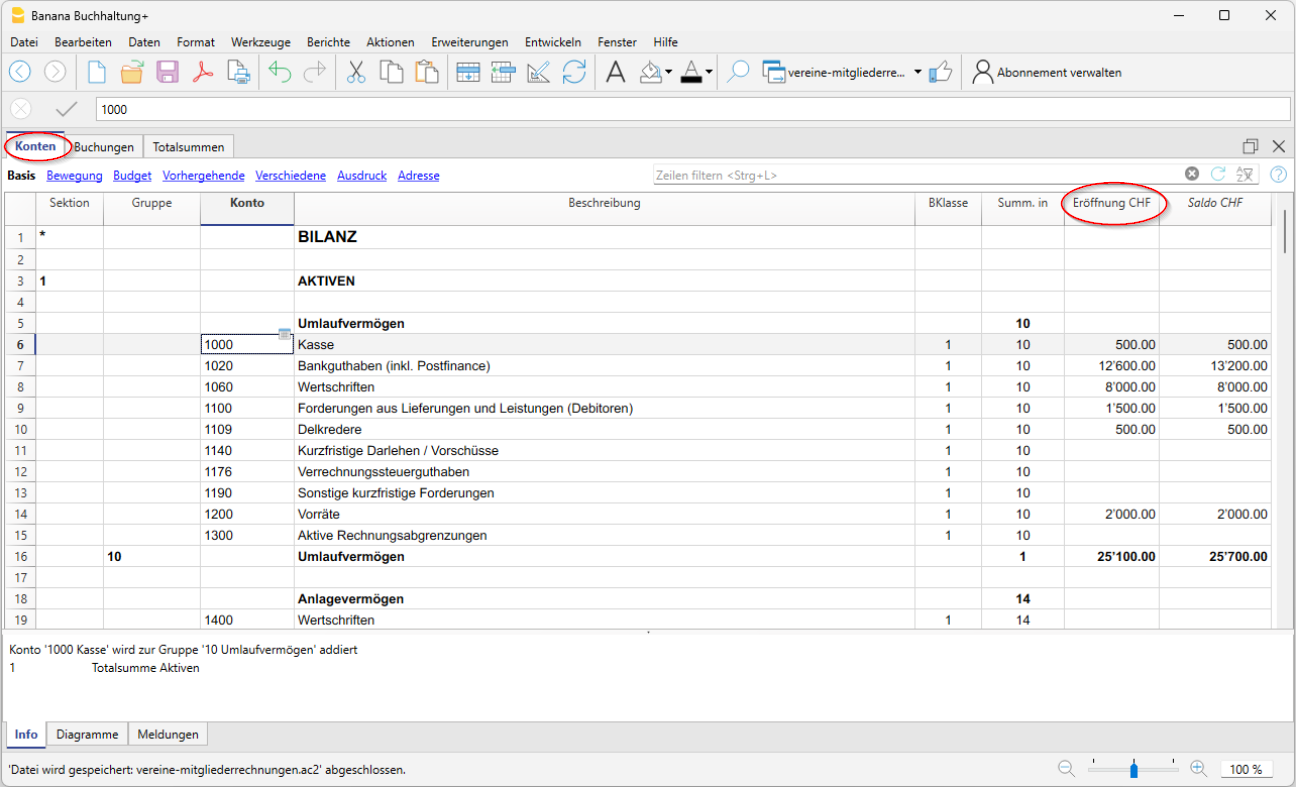
Erfolgsrechnung
Die Erfolgsrechnung bzw. Gewinn- und Verlustrechnung ist in Einnahmen und Ausgaben mit den folgenden Untergruppen unterteilt:
Ertrag
- Mitgliederbeiträge
- Erlöse aus Beiträgen
- Erlöse aus Aktivitäten und Dienstleistungen
- Sonstige Erlöse
Aufwand
- Kosten für Tätigkeiten und Dienstleistungen
- Personalaufwand
- Verwaltungskosten
- Abschreibungen und Wertberichtigungen
- Finanzielle Erträge und Aufwendungen
- Direkte Steuern
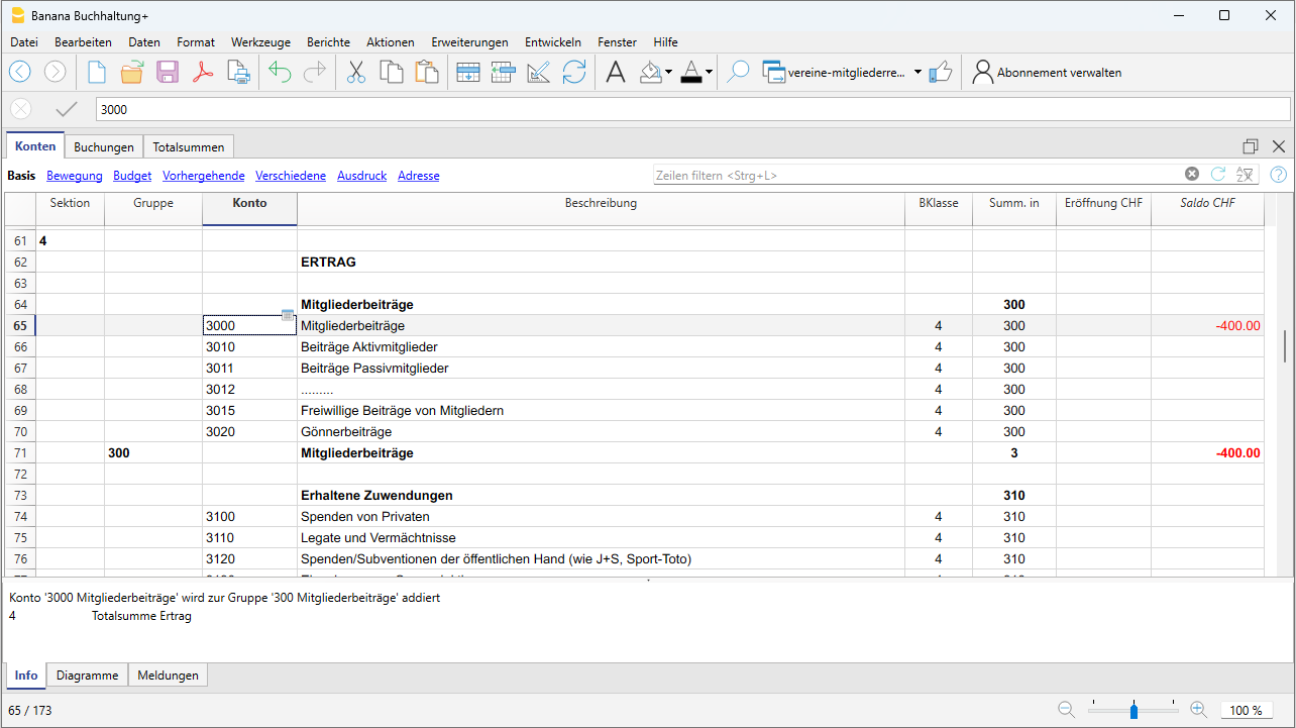
Sonstige Bestandteile des Kontenplans
Die Kosten- und Profitstellen werden am Ende des Kontenplans eingerichtet, um alle Details der folgenden Gruppen zu erhalten:
- Mitglieder mit Kostenstellen KS3 (;) - Diese ermöglichen es Ihnen, die Detailtransaktionen für jedes Mitglied einzusehen, sowie Rechnungen für Mitgliedsbeiträge, Rundschreiben an Mitglieder, Spendenaufforderungen und Spendenbescheinigungen auszudrucken.
- Kosten- und Profitstellen mit KS1 (.) - Diese erlauben es Ihnen, über die Detailtransaktionen jedes Vereinsprojekts zu verfügen bzw. diese anzuzeigen.
- Aktivitätsbereiche mit Segmenten - Um zu wissen, welcher Vereinsbereich am interessantesten war und den grössten Gewinn erwirtschaftet hat.
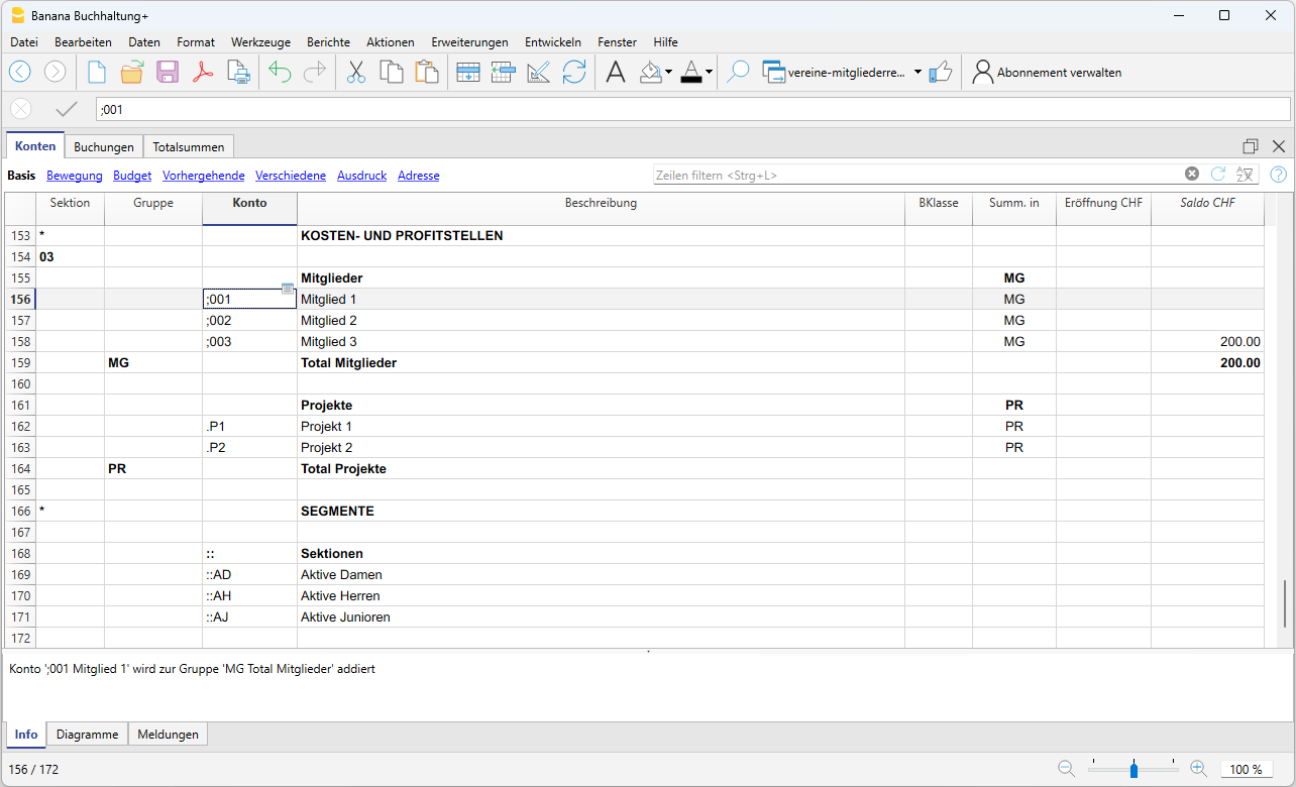
Liquiditätsplanung
Die Liquiditätsplanung ist der Hauptpfeiler des Vereins: Diese ermöglicht es, Ihre Vereinsaktivitäten durchzuführen, um die gesetzten Ziele Ihres Vereins zu erreichen; im Voraus zu sehen, wie viel Liquidität vorhanden sein wird, um die Risiken zu minimieren; und ständig zu überprüfen, ob die Zahlen Ihrer Buchhaltung mit dem von der Mitgliederversammlung genehmigten Budget übereinstimmen.
Banana Buchhaltung gibt Ihnen die Möglichkeit, sowohl die Liquiditätsplanung als auch die Finanzplanung zu erstellen.
Sie können die verschiedenen Funktionen der Finanzplanung in unserer Dokumentation entdecken:
Budget-Buchungen eingeben
Geben Sie das Budget in der Budget-Tabelle ein, basierend auf der Methode der doppelten Buchführung. Verwenden Sie den gleichen Kontenplan, der bereits für die Finanzbuchhaltung zur Verfügung steht. Sie müssen lediglich mit der Erfassung der Einträge beginnen, die normalerweise im Laufe der Monate stattfinden, indem Sie diese als Buchungen eingeben. Erfassen Sie auch die Bewegungen, die Sie nur einmal im Jahr haben werden oder die sich nur vierteljährlich wiederholen. In der Tabelle gibt es eine Spalte Wiederholung, die es dem Programm ermöglicht, je nach eingegebenen Zeitraum automatisch die Jahresgesamtsumme mit allen Details zu berechnen.
Wenn Sie die Buchungen eingeben, werden auch die Konten im Soll und im Haben erfasst, als ob Sie die tatsächliche Buchhaltung eingeben würden. Auf diese Weise erhalten Sie unter Verwendung aller im Kontenplan verfügbaren Konten alle Bewegungen der Liquiditätskonten, der anderen Bilanzkonten und der Gewinn- und Verlustrechnung.
Wir empfehlen Ihnen, mit den folgenden Buchungen zu beginnen, um sich einen Überblick zu verschaffen:
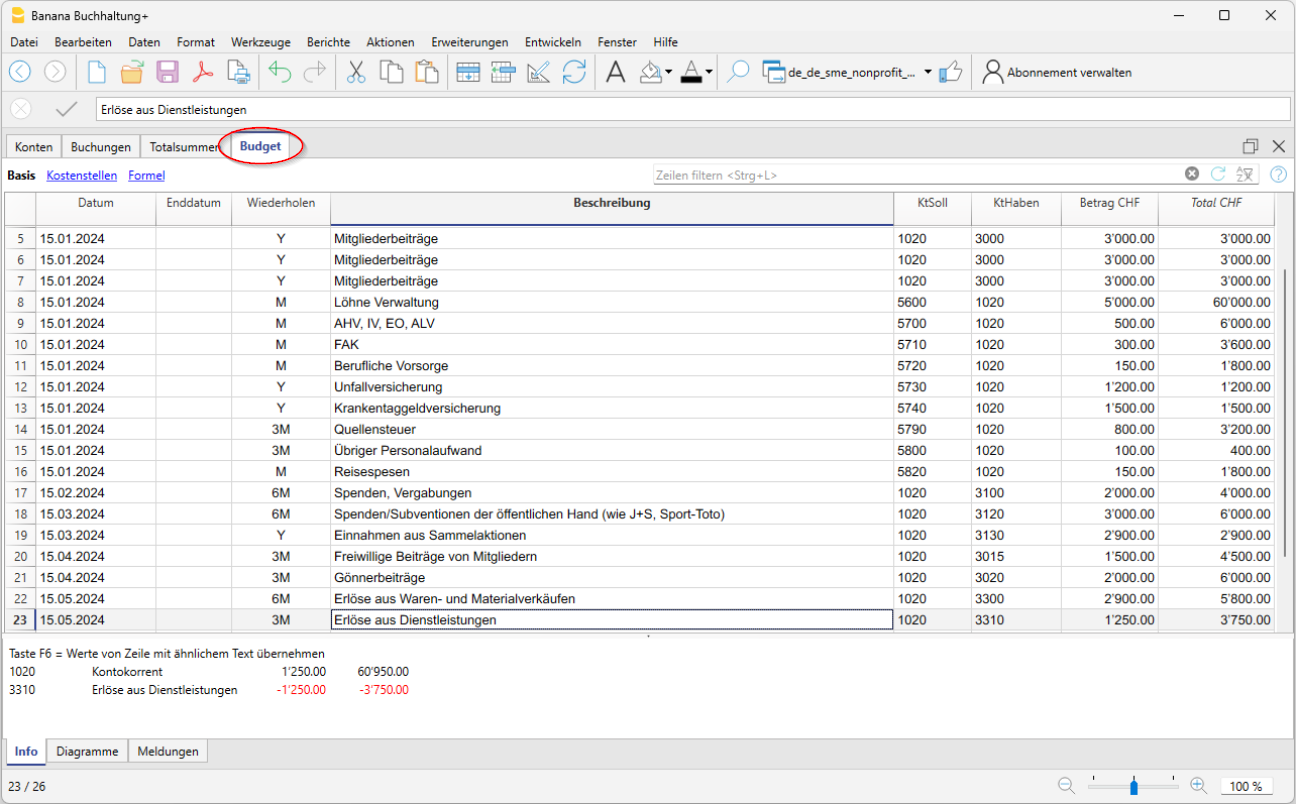
Für die Vereinserlöse ist es schwieriger, Prognosen zu erstellen. Wir raten Ihnen, diese Beträge auf der Grundlage der Vereinseinnahmen des gleichen Zeitraums des Vorjahres einzutragen und dabei die Vereinsanlässe zu beachten, die geplant sind, sowie auch andere besondere Ereignisse wie z. B. die Anschaffung neuer Geräte oder andere Investitionen.
Sie müssen immer in die Budget-Tabelle eingetragen werden, indem Sie die Konten der Erfolgsrechnung sowie der Liquiditätskonten verwenden.
Kontoauszug 'Budget'
Wenn Sie Ihr Vereinsbudget erfassen, können Sie alle Daten für jeden Kosten- oder Ertragsposten in den entsprechenden Registerkarten gruppieren lassen, genau wie die tatsächlich erfassten Daten.
Auf diese Weise können Sie alle Details jedes Kontoauszuges oder auch diejenigen einer Kontengruppe sehen und ständig überprüfen, ob die budgetierten Daten mit den gebuchten Daten übereinstimmen, dies auch dank der Grafik, die Ihnen eine sofortige Vergleichsmöglichkeit bietet.
Um eine oder mehrere Budget-Auszüge zu erhalten, gehen Sie wie folgt vor:
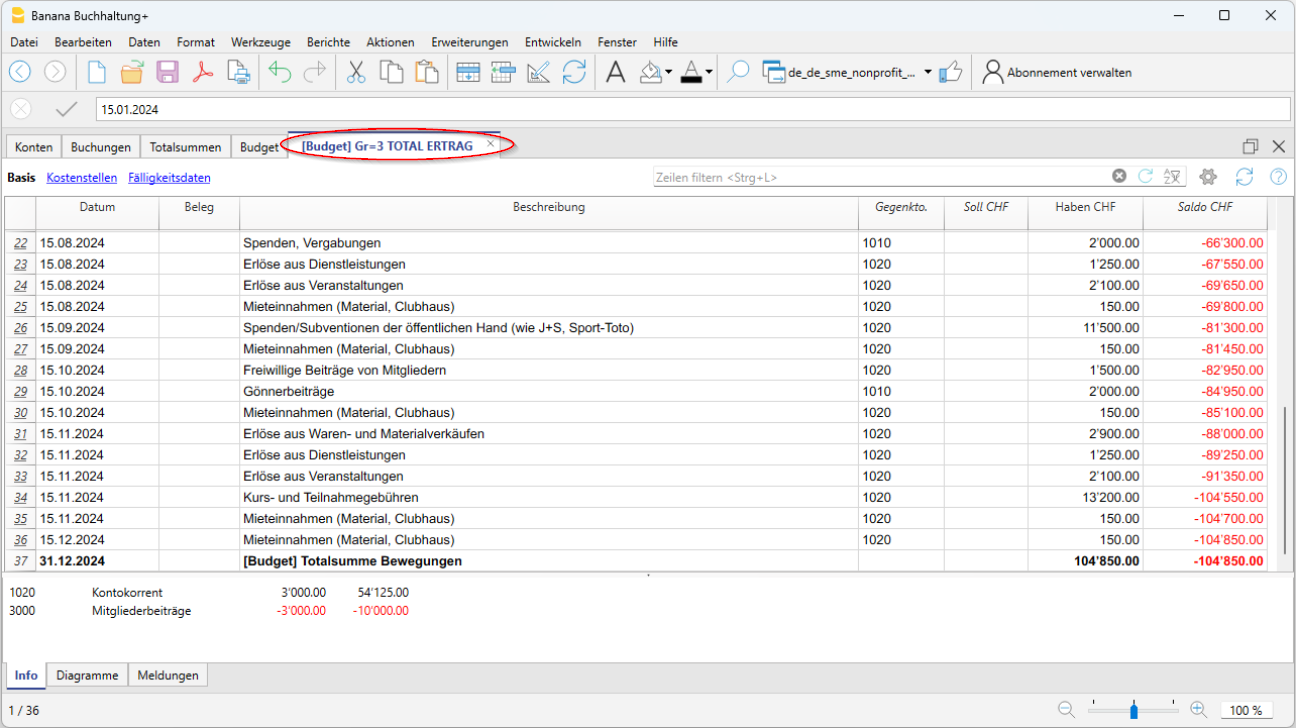
Budget Finanzplanung
Sobald Sie mit der Erfassung Ihrer Budgetbuchungen fertig sind, können Sie anhand der Bilanz und Erfolgsrechnung die Auswirkungen auf die Liquidität sehen. Sie können jederzeit auf die Budget-Tabelle zurückkehren und die Beträge für die Positionen ändern, die Sie für angemessen halten.
Die Cashflow-Planung ist eine sehr wirksame und erfolgreiche Strategie, die es Ihnen ermöglicht, Ihre Entscheidungen in Bezug auf die Vereinsaktivitäten des Vereins besser zu bewerten.
Um das Finanzplanungsbudget zu erhalten, gehen Sie wie folgt vor:
Menü Bericht > Formatierte Bilanz nach Gruppen > Sektion Spalten, im Bereich 'Bilanz' die Option Budget aktivieren.
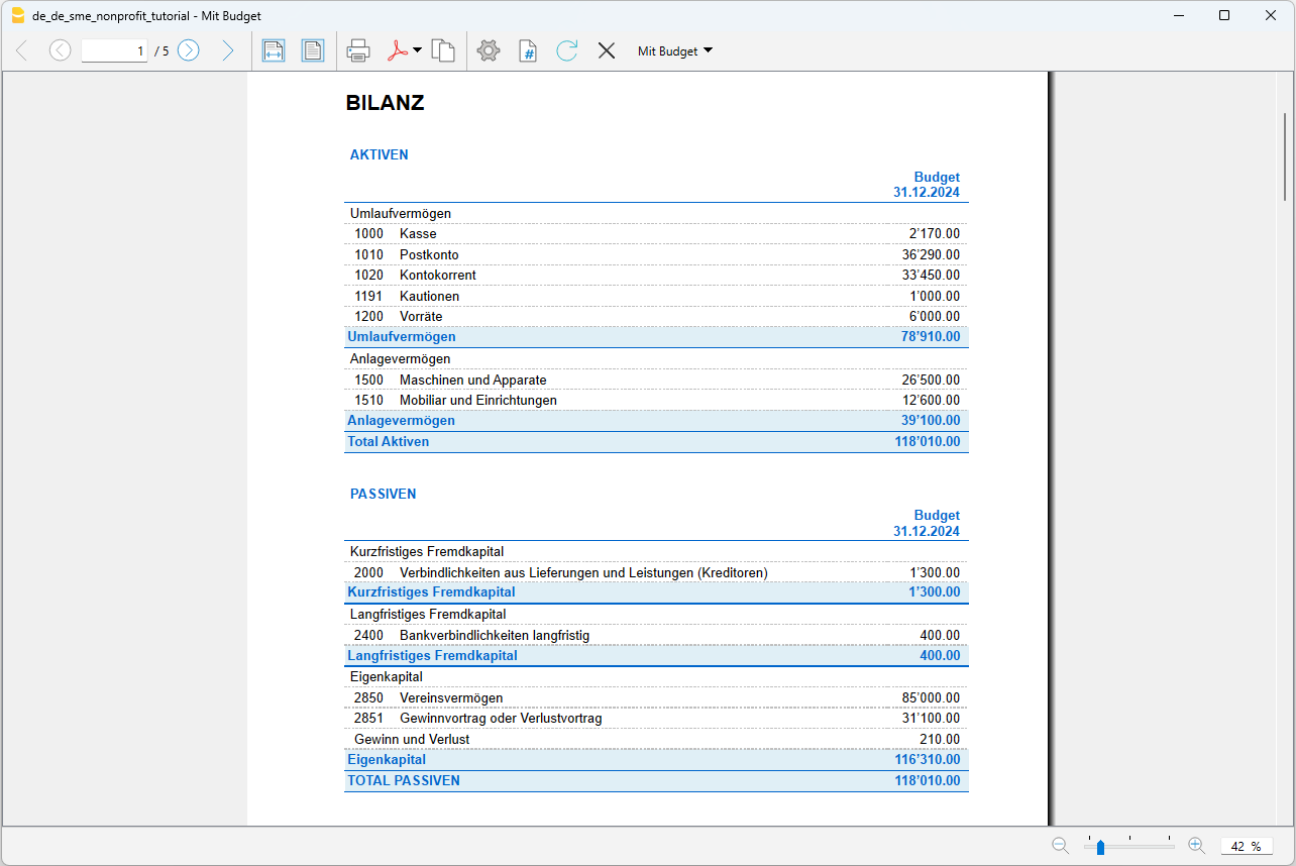
Prognostizierte Erfolgsrechnung
Mit der Erfolgsrechnung können Sie sehen, wie sich Ihre Prognose auf die Kosten und Einnahmen auswirkt und ob Sie mit den geplanten Einnahmen Ihre voraussichtlichen Kosten decken können.
Um die Erfolgsrechnung für Ihre Finanzplanung zu erhalten, gehen Sie wie folgt vor:
Menü Bericht > Formatierte Bilanz nach Gruppen > Sektion Spalten, im Bereich 'Erfolgsrechnung' die Option Budget aktivieren.
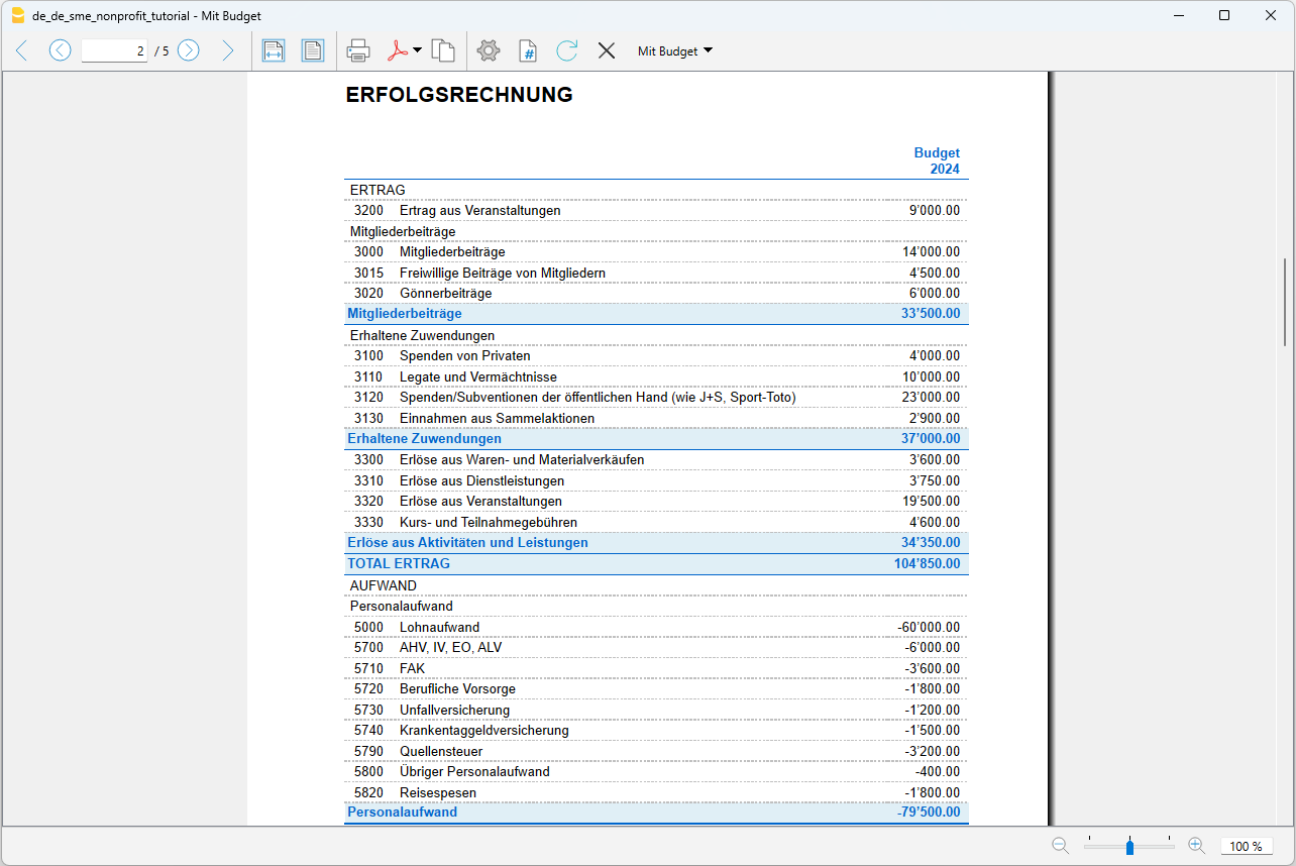
Effektive buchhalterische Transaktionen erfassen
In der Buchungen-Tabelle geben Sie alle täglichen Buchungen ein. Um die Eingabe zu beschleunigen, empfehlen wir Ihnen, die verschiedenen Funktionen von Banana Buchhaltung zu nutzen:
- Die Funktion für die Auto-Vervollständigung für die Dateneingabe erlaubt Ihnen, bereits eingegebene Daten automatisch wieder abzurufen.
- Die Funktion der Sich wiederholenden Buchungen (Menü Aktionen) erlaubt Ihnen, in einer speziellen Tabelle Buchungen zu speichern, welche wieder vorkommen werden.
- Der Import der Daten Ihres Bankkontoauszuges ermöglicht es Ihnen, alle Bankbewegungen automatisch zu übernehmen.
- Sie können jede Buchung mit dem entsprechenden Beleg in digitaler Form verknüpfen und diesen mit einem einfachen Mausklick anzeigen.
Sehen Sie bitte auch Buchhaltungsdateien und digitale Belege, um Ihre Dokumente besser zu organisieren. - Verwenden Sie den Befehl Zeilen sortieren > nach Datum, um die Buchungszeilen nach Datum zu sortieren.
- Verwenden Sie den Befehl Ausdrucken/Druckvorschau, um das Journal zu drucken oder in PDF-Format zu exportieren.
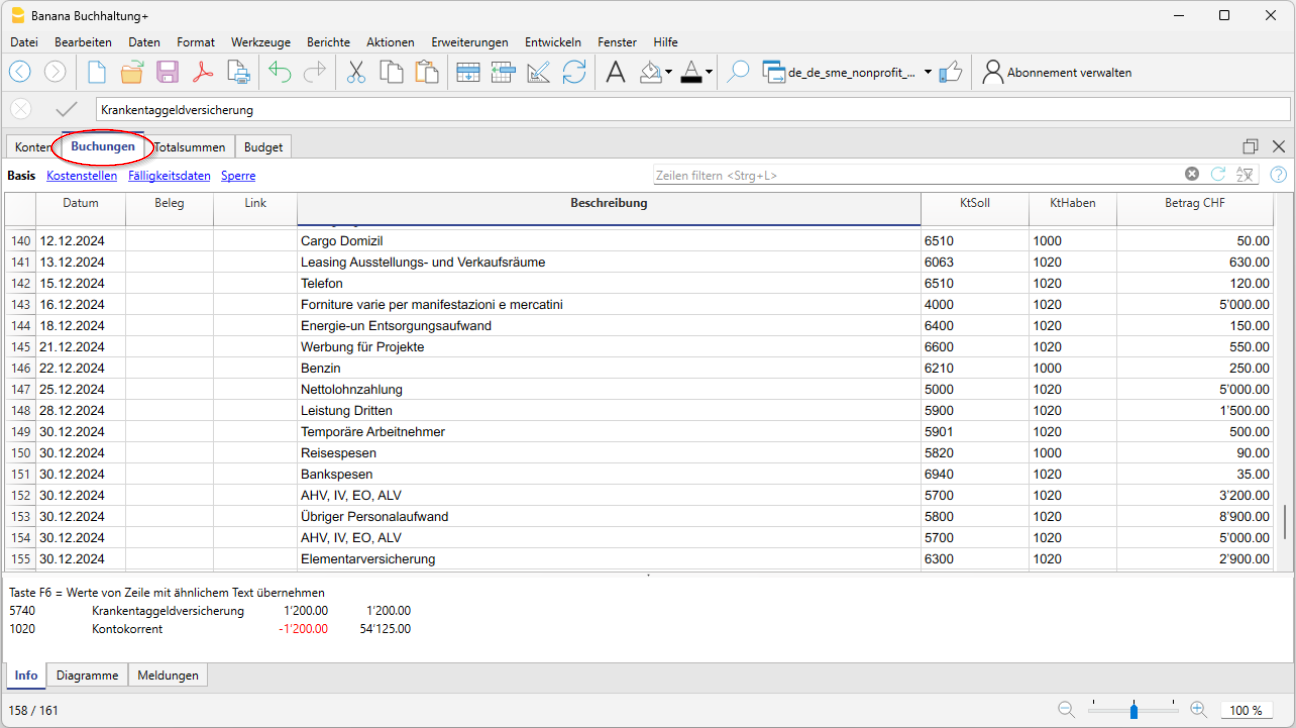
Formatierte Bilanz
Um die Bilanz und Erfolgsrechnung anzuzeigen, fühlen Sie aus Menü Berichte den Befehl Formatierte Bilanz oder Formatierte Bilanz nach Gruppen aus. Sie können den Bericht mit den von Ihnen gewünschten Spalten anpassen, z.B. mit einer Spalte für Ihr Budget oder ihn nur für einen eingeschränkten Zeitraum erstellen.
- Die Formatierte Bilanz bildet alle Konten ohne Zwischentotale ab.
- Die Formatierte Bilanz nach Gruppen bildet alle Konten mit Untergruppen bzw. Zwischentotalen ab.
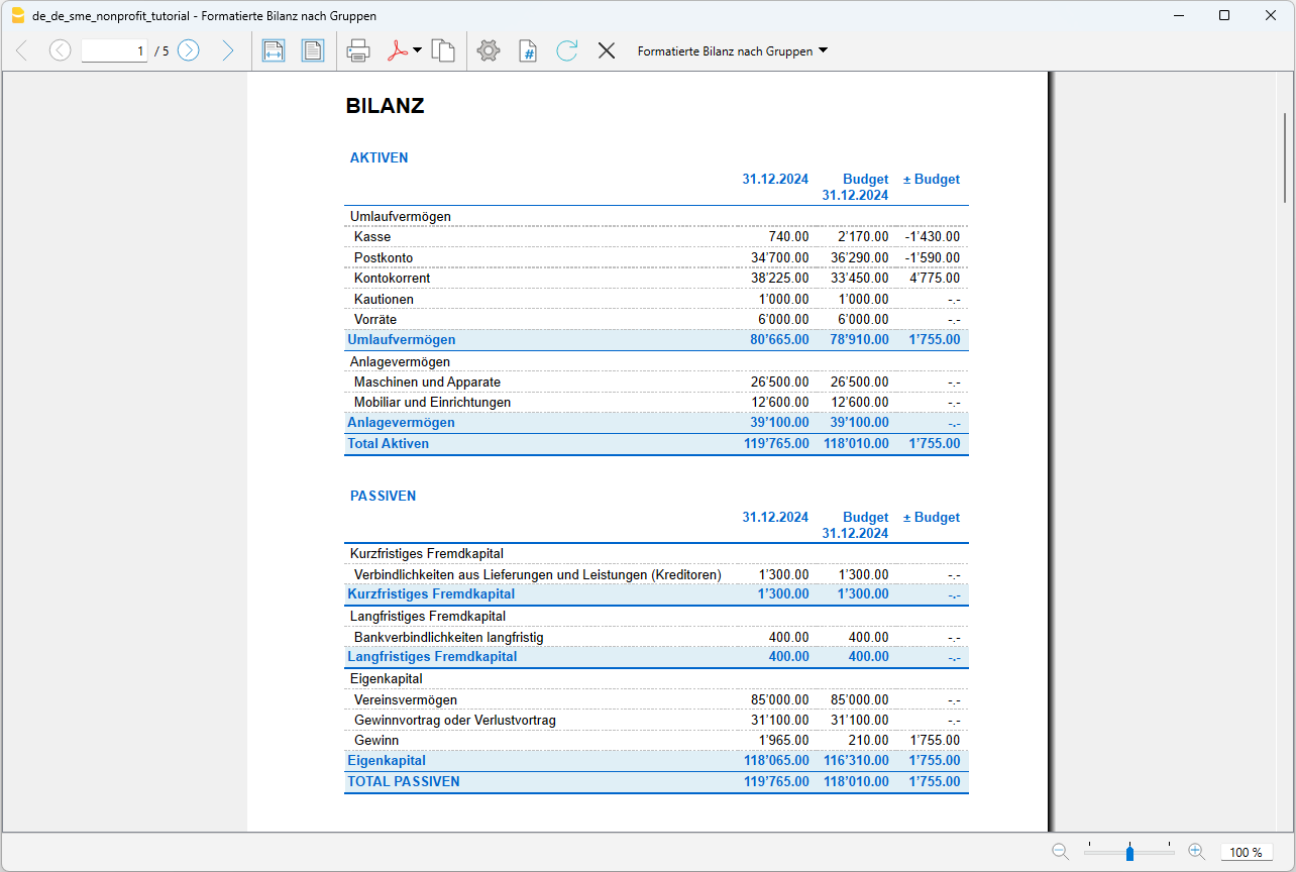
Vergleich der Salden mit dem Budget
Nachdem die effektiven buchhalterischen Transaktionen erfasst wurden, können Sie die Bilanz und Erfolgsrechnung e und erstellen und den Vergleich mit dem Budget vornehmen. Diesen Vergleich im Auge zu behalten ist wichtig, um zu überprüfen, ob alles so läuft, wie Sie es geplant war, oder ob es notwendig ist, Ausgaben zu reduzieren oder verschieben müssen, um das Budget besser einzuhalten die Buchwerte besser abzustimmen und die Finanzplanung für die kommenden Monate nicht zu gefährden.
Um die Bilanz und Erfolgsrechnung mit Endsalden und den Vergleich mit dem Budget zu erhalten, gehen Sie wie folgt vor:
Menü Bericht > Formatierte Bilanz nach Gruppen > Sektion Spalten für Bilanz sowie für Erfolgsrechnung je die Spalten Laufende, Budget sowie Differenz (rechts von Budget). aktivieren.

Invoices to members in double-entry accounting
Invoices to members in double-entry accountingCreate your file
To get started quickly, we recommend downloading the template provided at the beginning of this page, or opening it directly from the program as follows:
- Open the template with the Banana Accounting Plus WebApp
- Using the File > File Properties command, set the period, your organisation's name, and base currency
- Using the File > Save As command, save the file. It's useful to include the name of the organisation and the year in the filename. For example "Association...-20xx.ac2".
Enter the basic information of the organisation
In the menu File > File Properties > Accounting, enter your organisation’s data, start and end dates, and base currency.
In the Address section, fill in the required fields. These details are essential for invoice headers.

Insert the logo and define the invoice header position
To insert the organisation’s logo and define the position of the various headers on the invoice, go to the menu File > Set Logo.
For more details, visit the page Set Logo

Enter members' data
In the Accounts table, at the end of the chart of accounts, enter all members of the organisation using the cost center CC3, which uses a semicolon.
In the Addresses view, fill in the various columns with the members' details. For each member, you can specify the invoice language in the Language column.
If you selected a different template that does not include the Addresses view, you can activate it from the menu Tools > Add New Features > Add Addresses and fill in the requested columns.

Set the Members Group
Once you have created the member list with a grouping code, you need to define this group in the invoice settings:
From the menu Report > Customers > Settings, select the members' grouping code. In our tutorial it is indicated as TM (Total members).

Prepare and print member invoices
Enter the invoice data in the Transactions table. You only need to fill in the following fields:
- Date
- Description
- Invoice number (essential for invoice printing)
- Membership fee amount
- In the CC3 column, enter the cost center for the member that you defined at the end of the chart of accounts, but without the semicolon.
- The Debit and Credit columns remain empty.

Now you're ready to print the invoices. Proceed as follows:
- From the menu Report > Customers > Print Invoices, access the dialog where you can select one or more invoices to print, choose the layout, and adjust settings for customization.

In the Options section, you can enter notes for the member and define the language.

Invoice

Further information:
- Layout with Swiss QR Code (Banana+)
- Import ISO 20022 file (See section on national specifications)
Non-profit organisations with VAT | Double-entry accounting
Non-profit organisations with VAT | Double-entry accountingChart of accounts structured with groups and subgroups. Swiss VAT codes are already set up to automatically generate a sample VAT return and the XML file for electronic submission of VAT data on the FTA’s online platform (available only with the Advanced plan). Member and project management using cost centers.
The chart of accounts has a stepped format that allows you to see the composition of the operating result even at intermediate stages.
- You can customize the accounts to suit your specific needs.
- By setting up the member list, you can issue invoices for subscription fees, with the advantage of having them automatically recorded in the accounting.
- The VAT Codes table is updated with the new 2024 VAT rates.
- To speed up data entry, you can import banking transactions using Rules: for each imported transaction, enter a keyword (Rule) to automatically complete the other elements of the transaction (counter account, VAT code, cost center...); in future imports, the program will automatically complete the transaction every time it finds that keyword, significantly reducing workload and minimizing errors.
Many automation features, such as importing banking data using Rules, the sample VAT Form with the new 2024 rates, the XML file for electronic VAT submission, filters, and many others, are included exclusively in the Banana Accounting Plus Advanced plan.
Create your file
- Open the template with the Banana Accounting Plus WebApp
- Use the File > File Properties command to set the period, your organisation’s name, and base currency (you can do budgeting and accounting in any currency you choose).
- Use the File > Save As command to save the file. It is useful to include the organisation name and year in the filename. For example: "Association...-20xx.ac2".
WARNING: if you close the browser without saving, you will lose any data entered. Always save the file to your computer.
In our Documentation you’ll find all the information and insights to manage your accounting effectively:
Non-profit organisations | Multi-currency double-entry accounting
Non-profit organisations | Multi-currency double-entry accountingManage members, projects, and activities using cost centers and segments. Automated member subscriptions and donation certificates.
In our Documentation you’ll find all the information and insights to manage your accounting efficiently:
Non-profit organisations with VAT | Multi-currency double-entry accounting
Non-profit organisations with VAT | Multi-currency double-entry accountingChart of accounts with a very simple structure of groups and subgroups. Swiss VAT codes are already set up to automatically generate a sample VAT report and the XML file for electronic VAT data submission to the FTA’s online platform (Advanced plan only).
All the settings and features you need for:
- Creating and printing invoices with Swiss QR code
- Importing data from bank statements
- Setting up Rules to save and automate the completion of transactions imported from bank statements.
- Managing VAT according to the new VAT rates
- Managing cost centers, customizable to suit your needs to get detailed insights into specific accounts.
- Creating budgets and financial forecasts
- Printing all the reports you need: Balance Sheets, Journal, Account Cards, VAT Reports, Open Invoices and much more.
For managing VAT with the new rates, you can find detailed information on the VAT Management page.
Some features require a subscription to the Banana Accounting Plus Advanced plan, such as generating the sample or XML VAT Report, using new features like Rules, Filter and Temporary Row Sorting. See all Advanced plan features.
Create your file
- Open the template with the Banana Accounting Plus WebApp
- From the menu File > File Properties set the period, your company name, and base currency in any currency you want.
- From the menu File > Save As, save the file. It’s useful to include your company name and year in the file name. For example: "Rossi-SA-20xx.ac2".
- In the Exchange Rates table, set up foreign currencies always in reference to the base currency. Opening exchange rates are set only the first time Banana Accounting is used. At the new year transition, these are automatically carried forward using the closing exchange rates as of 31.12.
WARNING: If you close the browser without saving, you will lose any entered data. Always save the file to your computer.
To reopen the saved file, click on File > Open.
In our Documentation you’ll find all the information and insights you need to manage your accounting effectively:
GAAP FER 21 Templates
The chart of accounts we offer is set up according to the NGO model, as published in the PDF manual by the FGC (Fédération Genevoise de Coopération), where the SWISS GAAP RPC standards are presented and the proper accounting practices are explained.
Gemeinnützige Nonprofit-Organisationen | Vorlage gemäss den Swiss GAAP FER 21 Normen | Doppelte Buchhaltung
Gemeinnützige Nonprofit-Organisationen | Vorlage gemäss den Swiss GAAP FER 21 Normen | Doppelte BuchhaltungDer von uns vorgeschlagene Kontenplan ist nach dem NGO-Modell (Non-Governmental Organisations bzw. Nichtregierungsorganisation) aufgebaut, das im PDF-Handbuch der FGC (Fédération genevoise de coopération) veröffentlicht ist, in dem die SWISS GAAP RPC-Standards vorgestellt und die korrekte Buchführung erläutert werden.
Referenzen:
Enthält auch Kostenstellen, um Mitglieder, Projekte und Segmente zu verwalten.
In unserer Dokumentation finden Sie alle Informationen und Erkenntnisse, die Sie benötigen, um Ihre Buchhaltung optimal zu führen:
Gemeinnützige Nonprofit-Organisationen | Vorlage gemäss den Swiss GAAP FER 21 Normen | Doppelte Buchhaltung mit Fremdwährungen
Gemeinnützige Nonprofit-Organisationen | Vorlage gemäss den Swiss GAAP FER 21 Normen | Doppelte Buchhaltung mit FremdwährungenDer von uns vorgeschlagene Kontenplan ist nach dem NGO-Modell (Non-Governmental Organisations bzw. Nichtregierungsorganisation) aufgebaut, das im PDF-Handbuch der FGC (Fédération genevoise de coopération) veröffentlicht ist, in dem die SWISS GAAP RPC-Standards vorgestellt und die korrekte Buchführung erläutert werden.
Referenzen:
https://fgc.federeso.ch/sites/default/files/fgc_manuel_rpc21.pdf
In unserer Dokumentation finden Sie alle Informationen und Erkenntnisse, die Sie benötigen, um Ihre Buchhaltung optimal zu führen:
Membership list
To manage your members, you can start from one of the following templates (with example entries):
- Income/Expense Accounting for Associations in Switzerland
- Double-entry Accounting for Associations in Switzerland
With Banana Accounting Plus, you can set up a member list with address data and other configurations. You can then automatically generate:
- Member Invoicing (using integrated invoicing)
- Member account cards with all transactions and balances
- Donation certificate
- Letters to members / Mail merge
Below is how to set up the member list as cost centers (cash-based accounting).
In a later section, you’ll find how to set up the member list with active accounts if using accrual accounting.
Set up member accounts – cash-based accounting
Associations that use cash-based accounting must configure member accounts with cost center CC3 (;). Membership fees are recorded as income upon receipt. The member code appears as supplementary information.
- In the Section column, insert an asterisk to change the section.
- In the next row’s Section column, insert 04 for income.
- Use cost center CC3 (;) for each member account.

Enter address data
Member data such as address, phone, and email are entered in dedicated columns visible in the Addresses view. If the view is not visible, add it from the menu Tools > Add/Remove Features > Add Address columns in Accounts table.
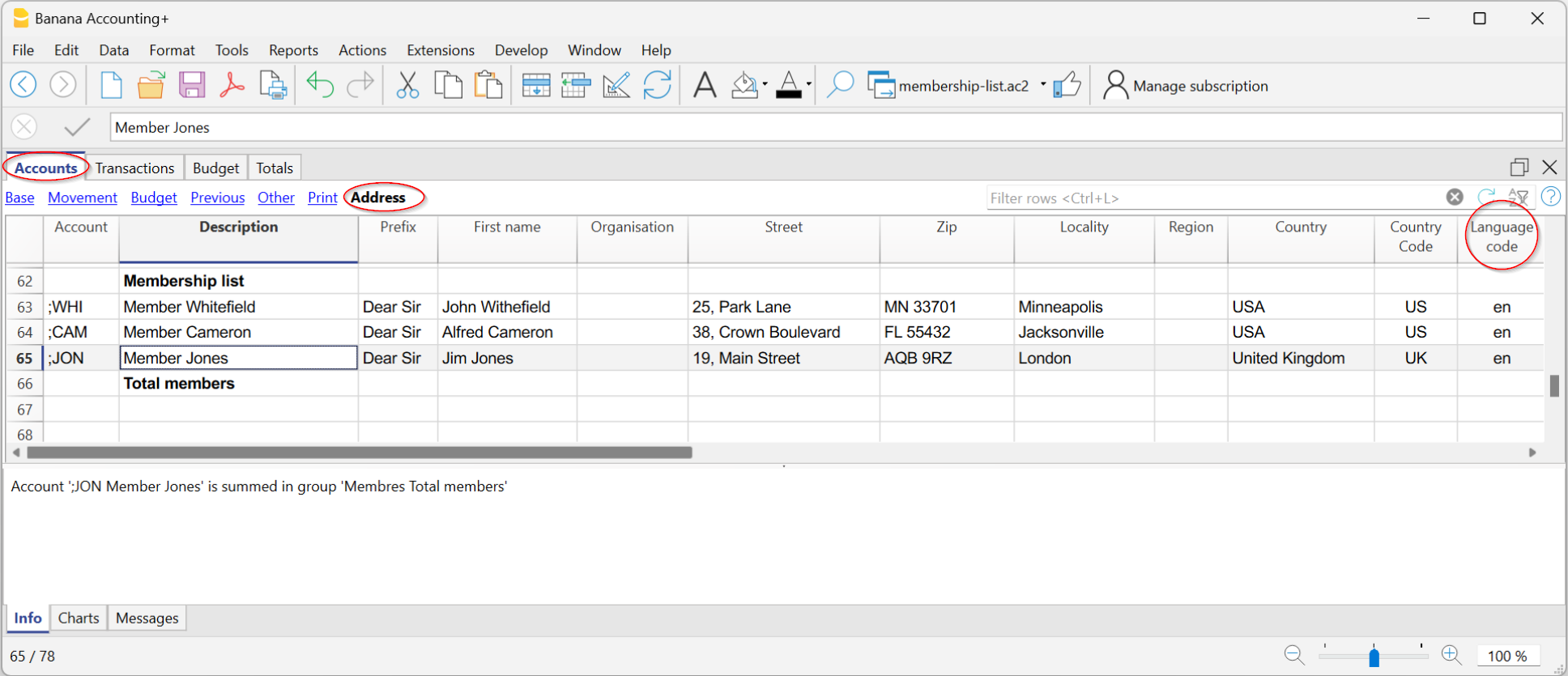
Enter membership fee payments in CC3
Payments and other entries related to members are recorded in the Transactions table. If members were set up with CC3, record as follows:
- Enter date and document number
- Enter description
- In the Debit column, enter the bank account; in Credit, the donation income account
- In the CC3 column, enter the member account (without punctuation)
If the CC3 column is not visible, go to Data > Organize Columns > CC3 and enable visible.

You can view each member’s transactions and balance in the account card by clicking the blue icon in the cell, or via Reports > Account cards.

Invoices for membership fees
With entries set (either with CC3 or ledger), you can generate membership fee invoices:
- From the menu Reports > Customers > Print invoices, access the dialog to customize and print invoices.
For more details, see the tutorial Invoices for membership fees.

Donation certificate for members
If income is recorded with member information, you can use the extension to print donation certificates. This automatically prepares a letter with member payment info.
Print member list
- Select the member rows in the Accounts table
- Go to File > Print and choose Print selection
You can also use the Extract Rows command to filter accounts, then print the displayed table.
Export member data
- Use the Extract Rows command
- Copy/paste data from Banana Accounting Plus into Excel
- Export data to CSV or Excel
Set up member accounts – accrual-based accounting
Associations using accrual accounting can set up members as standard asset accounts or subledger accounts at the end of the chart of accounts.
The fee is recorded as income when the invoice is issued (or at the start of the period) by debiting the member account. Upon payment, the member account is credited.
Detailed instructions on setting up member accounts in this case are the same as for Customer subledger.

Registering and invoicing membership fees with member subledger
- Enter the date and document number
- Enter the description and invoice number
- In the Debit column, enter the member account; in Credit, the donation income account

Related documents
Donation certificate for non-profit organizations
Banana Accounting Plus allows you to create donation certificates in letter format for non-profit organizations in Switzerland in a very simple, fast way and without the need for external tools like Word.
This extension is only available with the Integrated invoicing.
For more information, see the page:
The following templates are available to get started (with examples):
- Income/Expense accounting for non-profit organisations in Switzerland
- Double-entry accounting for non-profit organisations in Switzerland
Related documents
QR invoices to members
Banana Accounting Plus allows you to create QR-coded invoices for Switzerland, including the letters to be sent to members.
More information can be found at the following links:
- QR-code Invoices to members for annual membership fees
- Letter with Swiss QR slip to be sent to members
- Bulk QR-Invoices from Excel data list - Advanced plan only
With the Advanced plan of Banana Accounting Plus you can create more customisations and get free support for up to 3 cases per year.
Free text letter
The extension allows you to create a free text letter for the members registered in Banana Accounting Plus (Accounts table).
For more information visit the page:
Letters to members with mail merge of Word
Banana Accounting allows you to export data, which can be used to create documents in Word. For example, you can create letters of request for payment of associative fees where addresses are inserted thanks to the Word mail merge command.
Suppose we want to write a letter to be sent to each member: the content of the letter will be the same for all, but the address must be different for each letter. To avoid editing all addresses manually, we can use the Word mail merge feature .
Below we explain how to use the function with Windows, for Mac please refer to the relevant documentation of Word.
Use the following steps:
- Create a Membership list in Banana Accounting (Income & Expense Accounting or Double-entry accounting file).
- Export the address lines from Banana Accounting in HTML format.
- Use the Print merge feature of Word.
Reference documentation
Export address lines from Banana Accounting in HTML format
The first step is to export addresses from Banana Accounting in html format, so that Word can read and use them:
- In the Accounts table select Address view.
- Select the lines of the addresses that you wish to export.
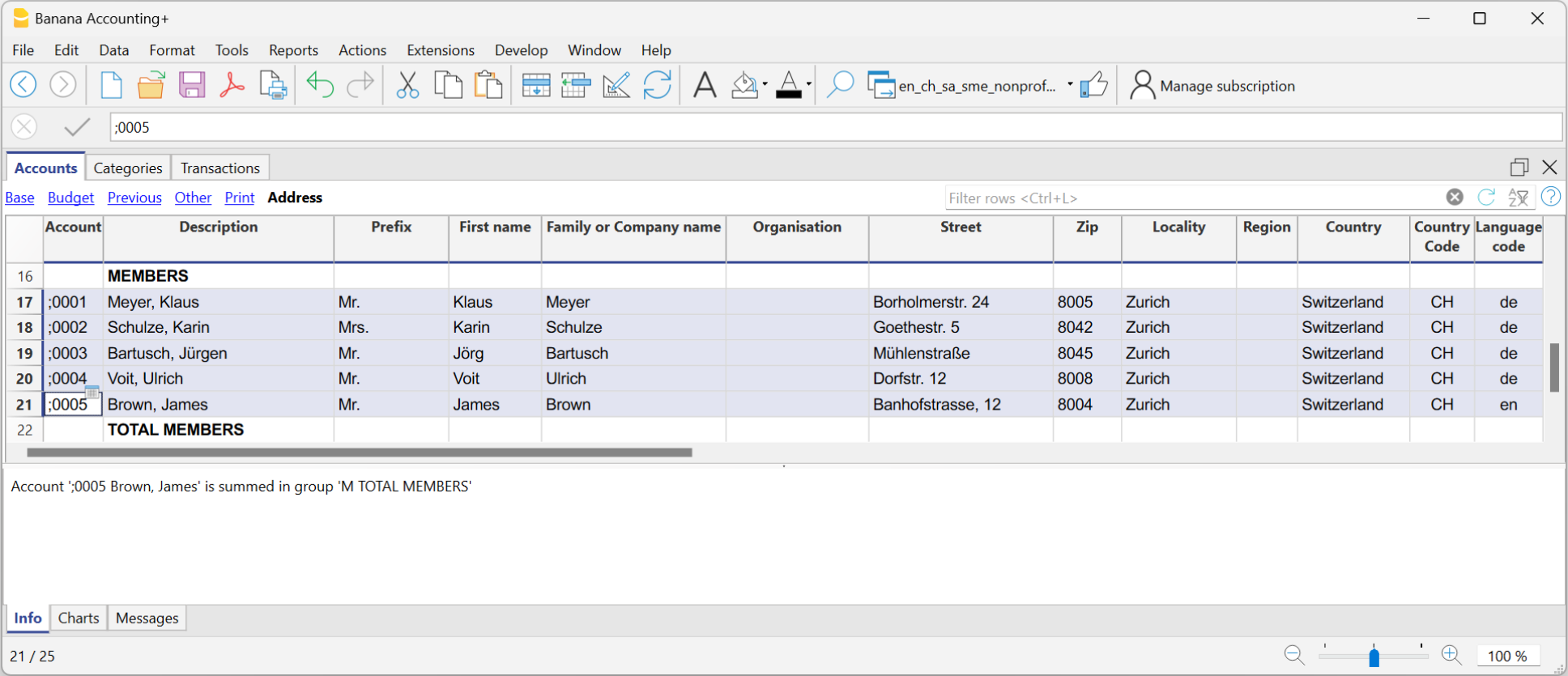
- From the Data menu select > Export rows > Export rows to Html
- In the dialog window:
- Enter the file name
- Click Browse... to select the file save location
- Insert a text in Header 1. The other fields are optional
- Make sure the Export selection only zone option is checked.
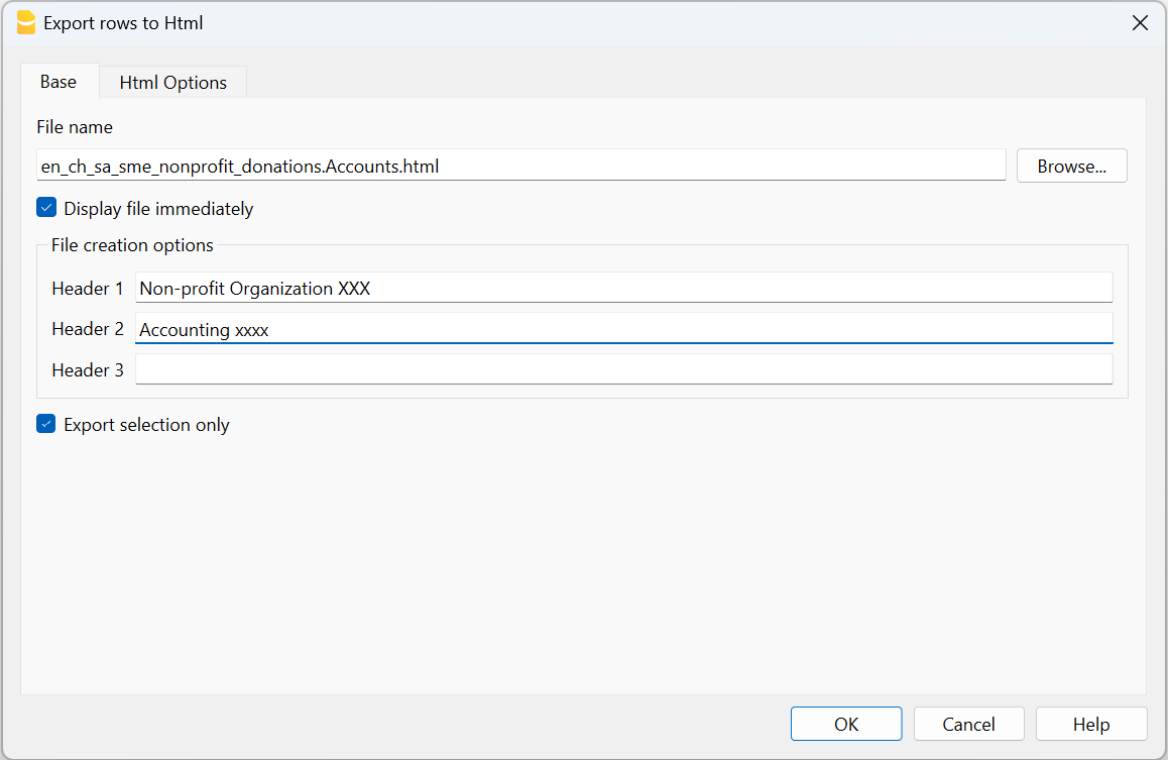
Open the Html Options section and make sure the options are displaying as shown in the image below.
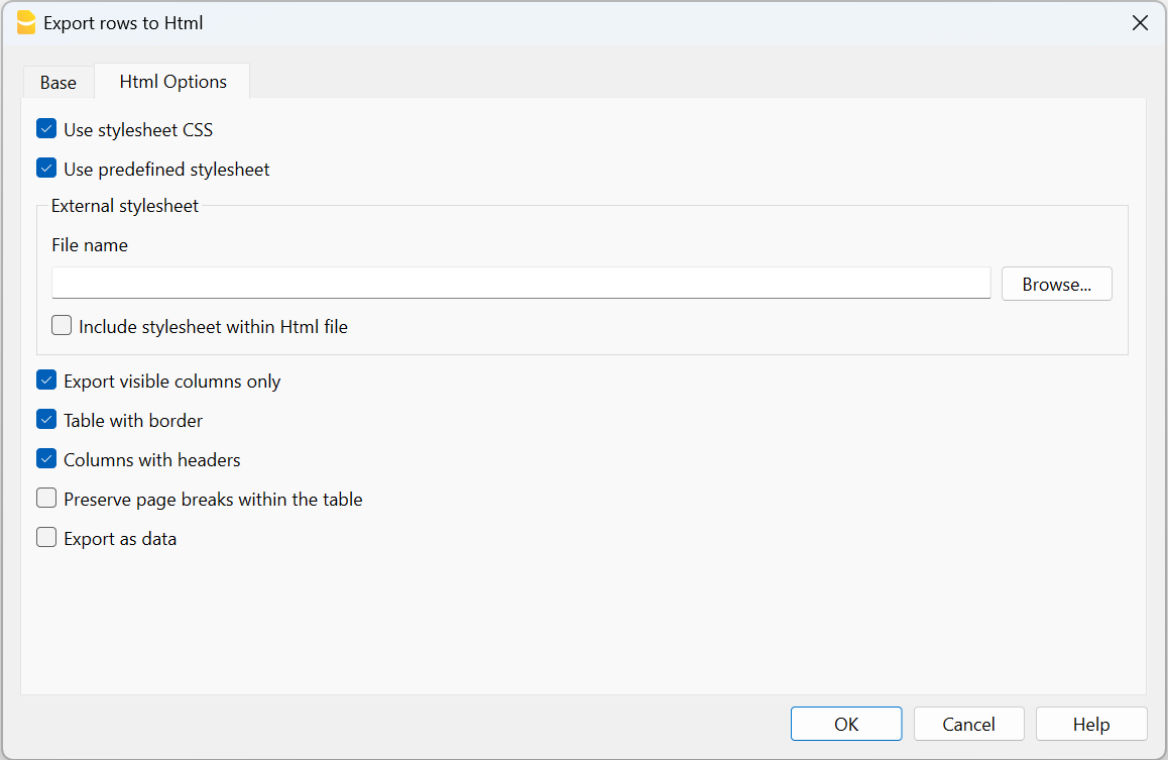
- Click OK to finalise the export of the lines in html format
Use the mail merge feature of Word
After export of addresses in html format, you can start working with Word and use the mail merge feature.
The procedure to follow is described below, but we recommend that you visit the Microsoft
- Create the letter:
- open Microsoft Word
- select the Mailings tab
- select Start Mail Merge
- select Letters
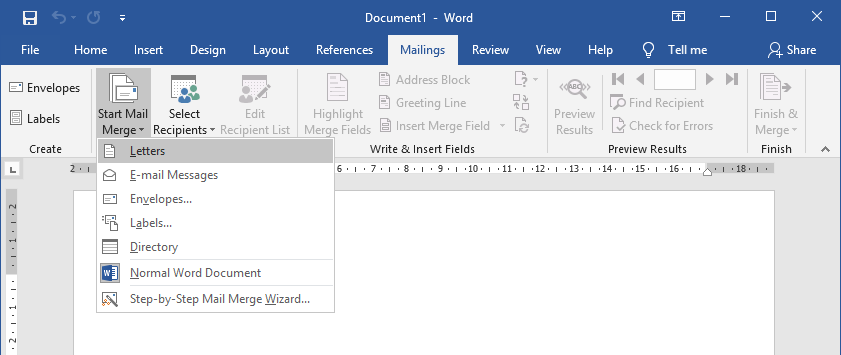
- type in the content of the letter in Word inserting the text that will be repeated for each document.
- Link the exported addresses of the HTML file to the Word document:
- in the Mailings tab select Select Recipients
- select Use an existing list
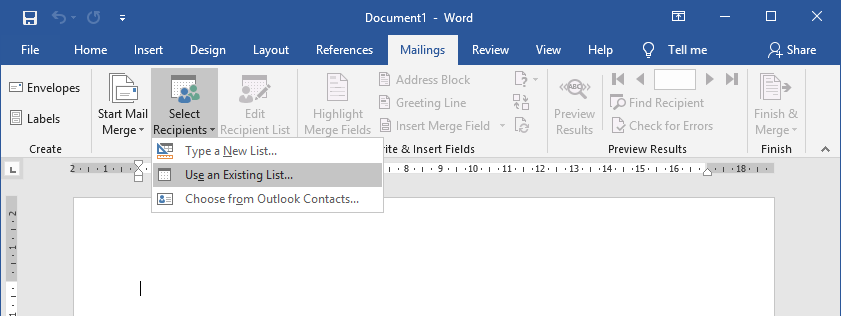
- select the .html file exported from Banana
- confirm with OK in the appearing window
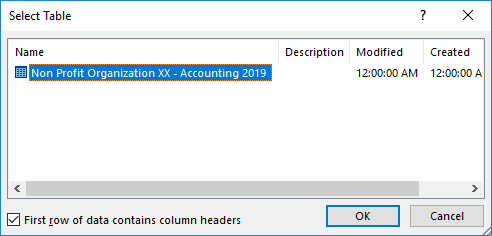
- Add the addresses:
- Place the cursor where you want the address to be inserted in the Word document, (for example, at the top of the page)
- In the Mailings tab select Insert Merge Field
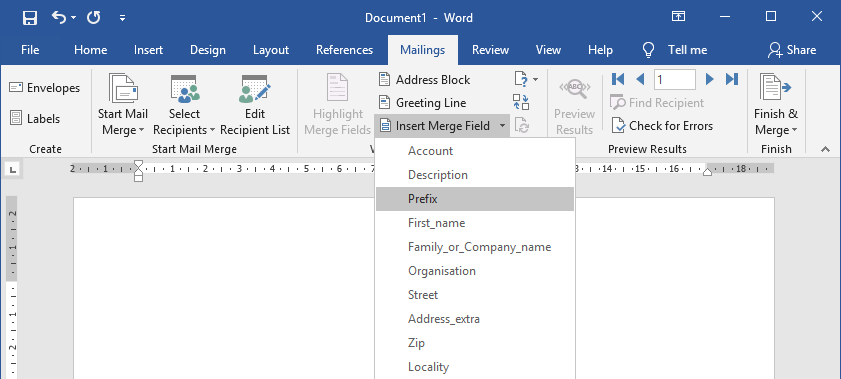
- One by one, select the address fields you wish to add
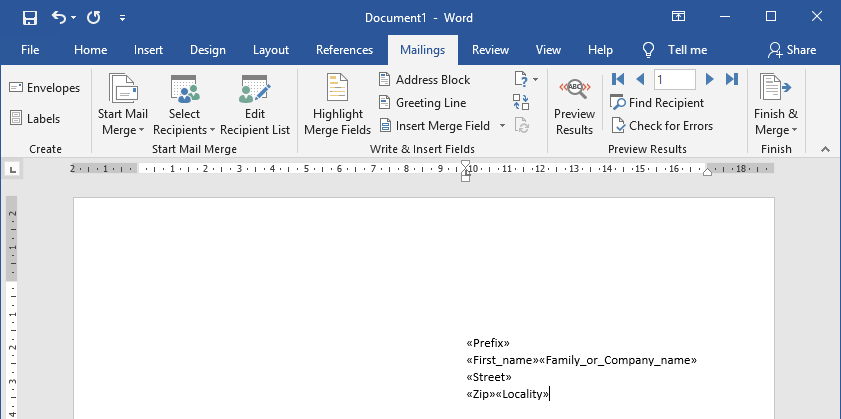
- Check with Preview Results using the forward
 and back
and back  darts
darts
- Print the letters:
- select Finish & Merge > Print Documents... to print all letters
- select Finish & Merge > Edit individual Documents... and All to eventually modify and save the letters

- Send messages by email:
As an alternative to step 4, you can choose to send letters by email.
For each member will be used the email address specified in the address view in Banana Accounting. If there are no email addresses you need to add them, and eventually export again the address lines in HTML format so that the exported file also contains the email addresses.
It is also necessary to install and use Outlook as email program. It's not possible to use the web version. More information at Use mail merge to send bulk email messages.
To send email messages:- select Finish & Merge > Send Email Messages...

- In the field "To" select Email_work (the column used in Banana Accounting for entering the email address).
- In the field "Subject line" enter the subject text of the email.
- In the "Mail Format" field select HTML (default setting).
- Select All to send the email to all members.
- Confirm with OK.
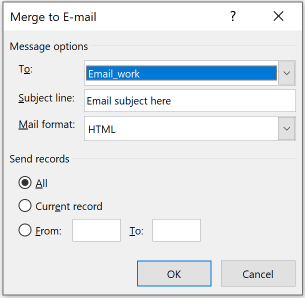
- select Finish & Merge > Send Email Messages...